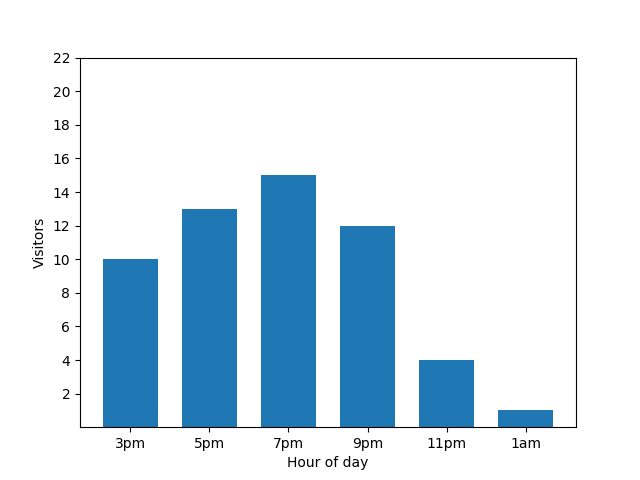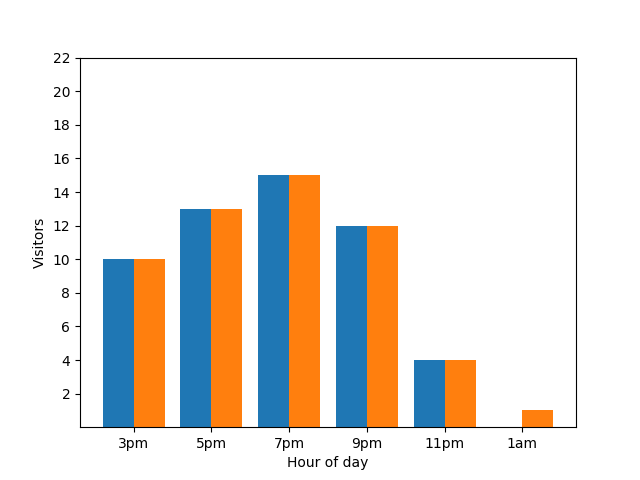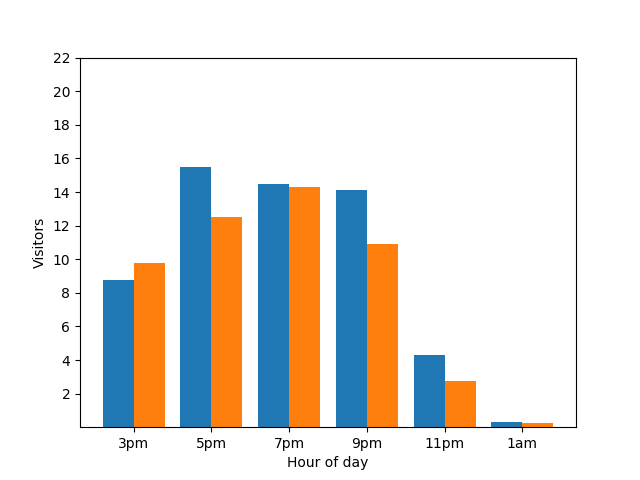This document provides general information about differential privacy for BigQuery. For syntax, see the differential privacy clause. For a list of functions that you can use with this syntax, see differentially private aggregate functions.
What is differential privacy?
Differential privacy is a standard for computations on data that limits the personal information that's revealed by an output. Differential privacy is commonly used to share data and to allow inferences about groups of people while preventing someone from learning information about an individual.
Differential privacy is useful:
- Where a risk of re-identification exists.
- To quantify the tradeoff between risk and analytical utility.
To better understand differential privacy, let's look at a simple example.
This bar chart shows the busyness of a small restaurant on one particular evening. Lots of guests come at 7 PM, and the restaurant is completely empty at 1 AM:

This chart looks useful, but there's a catch. When a new guest arrives, this fact is immediately revealed by the bar chart. In the following chart, it's clear that there's a new guest, and that this guest arrived at roughly 1 AM:

Showing this detail isn't great from a privacy perspective, as anonymized statistics shouldn't reveal individual contributions. Putting those two charts side by side makes it even more apparent: the orange bar chart has one extra guest that has arrived around 1 AM:

Again, that's not great. To avoid this kind privacy issue, you can add random noise to the bar charts by using differential privacy. In the following comparison chart, the results are anonymized and no longer reveal individual contributions.

How differential privacy works on queries
The goal of differential privacy is to mitigate disclosure risk: the risk that someone can learn information about an entity in a dataset. Differential privacy balances the need to safeguard privacy against the need for statistical analytical utility. As privacy increases, statistical analytical utility decreases, and vice versa.
With GoogleSQL for BigQuery, you can transform the results of a query with differentially private aggregations. When the query is executed, it performs the following:
- Computes per-entity aggregations for each group if groups are specified with
a
GROUP BYclause. Limits the number of groups each entity can contribute to, based on themax_groups_contributeddifferential privacy parameter. - Clamps each per-entity aggregate contribution to be within the clamping bounds. If the clamping bounds aren't specified, they are implicitly calculated in a differentially private way.
- Aggregates the clamped per-entity aggregate contributions for each group.
- Adds noise to the final aggregate value for each group. The scale of random noise is a function of all of the clamped bounds and privacy parameters.
- Computes a noisy entity count for each group and eliminates groups with few entities. A noisy entity count helps eliminate a non-deterministic set of groups.
The final result is a dataset where each group has noisy aggregate results and small groups have been eliminated.
For additional context on what differential privacy is and its use cases, see the following articles:
- A friendly, non-technical introduction to differential privacy
- Differentially private SQL with bounded user contribution
- Differential privacy on Wikipedia
Produce a valid differentially private query
The following rules must be met for the differentially private query to be valid:
- A privacy unit column is defined.
- The
SELECTlist contains a differentially private clause. - Only differentially private aggregate functions are
in the
SELECTlist with the differentially private clause.
Define a privacy unit column
A privacy unit is the entity in a dataset that's being protected, using differential privacy. An entity can be an individual, a company, a location, or any column that you choose.
A differentially private query must include one and only one privacy unit column. A privacy unit column is a unique identifier for a privacy unit and can exist within multiple groups. Because multiple groups are supported, the data type for the privacy unit column must be groupable.
You can define a privacy unit column in the OPTIONS clause of a
differential privacy clause with the unique identifier privacy_unit_column.
In the following examples, a privacy unit column is added to a
differential privacy clause. id represents a column that originates from a
table called students.
SELECT WITH DIFFERENTIAL_PRIVACY
OPTIONS (epsilon=10, delta=.01, privacy_unit_column=id)
item,
COUNT(*, contribution_bounds_per_group=>(0, 100))
FROM students;
SELECT WITH DIFFERENTIAL_PRIVACY
OPTIONS (epsilon=10, delta=.01, privacy_unit_column=members.id)
item,
COUNT(*, contribution_bounds_per_group=>(0, 100))
FROM (SELECT * FROM students) AS members;
Remove noise from a differentially private query
In the "Query syntax" reference, see Remove noise.
Add noise to a differentially private query
In the "Query syntax" reference, see Add noise.
Limit the groups in which a privacy unit ID can exist
In the "Query syntax" reference, see Limit the groups in which a privacy unit ID can exist.
Limitations
This section describes limitations of differential privacy.
Performance implications of differential privacy
Differentially private queries execute more slowly than standard queries
because per-entity aggregation is performed and the max_groups_contributed limitation
is applied. Limiting contribution bounds can help improve the performance of
your differentially private queries.
The performance profiles of the following queries aren't similar:
SELECT
WITH DIFFERENTIAL_PRIVACY OPTIONS(epsilon=1, delta=1e-10, privacy_unit_column=id)
column_a, COUNT(column_b)
FROM table_a
GROUP BY column_a;
SELECT column_a, COUNT(column_b)
FROM table_a
GROUP BY column_a;
The reason for the performance difference is that an additional finer-granularity level of grouping is performed for differentially private queries, because per-entity aggregation must also be performed.
The performance profiles of the following queries should be similar, although the differentially private query is slightly slower:
SELECT
WITH DIFFERENTIAL_PRIVACY OPTIONS(epsilon=1, delta=1e-10, privacy_unit_column=id)
column_a, COUNT(column_b)
FROM table_a
GROUP BY column_a;
SELECT column_a, id, COUNT(column_b)
FROM table_a
GROUP BY column_a, id;
The differentially private query performs more slowly because it has a high number of distinct values for the privacy unit column.
Implicit bounding limitations for small datasets
Implicit bounding works best when computed using large datasets. Implicit bounding can fail with datasets that contain a low number of privacy units, returning no results. Furthermore, implicit bounding on a dataset with a low number of privacy units can clamp a large portion of non-outliers, leading to underreported aggregations and results that are altered more by clamping than by added noise. Datasets that have a low number of privacy units or are thinly partitioned should use explicit rather than implicit clamping.
Privacy vulnerabilities
Any differential privacy algorithm—including this one—incurs the risk of a private data leak when an analyst acts in bad faith, especially when computing basic statistics like sums, due to arithmetic limitations.
Limitations on privacy guarantees
While BigQuery differential privacy applies the differential privacy algorithm, it doesn't make a guarantee regarding the privacy properties of the resulting dataset.
Runtime errors
An analyst acting in bad faith with the ability to write queries or control input data could trigger a runtime error on private data.
Floating point noise
Vulnerabilities related to rounding, repeated rounding, and re-ordering attacks should be considered before using differential privacy. These vulnerabilities are particularly concerning when an attacker can control some of the contents of a dataset or the order of contents in a dataset.
Differentially private noise additions on floating-point data types are subject to the vulnerabilities described in Widespread Underestimation of Sensitivity in Differentially Private Libraries and How to Fix It. Noise additions on integer data types aren't subject to the vulnerabilities described in the paper.
Timing attack risks
An analyst acting in bad faith could execute a sufficiently complex query to make an inference about input data based on a query's execution duration.
Misclassification
Creating a differential privacy query assumes that your data is in a well-known and understood structure. If you apply differential privacy on the wrong identifiers, such as one that represents a transaction ID instead of an individual's ID, you could expose sensitive data.
If you need help understanding your data, consider using services and tools such as the following:
Pricing
There is no additional cost to use differential privacy, but standard BigQuery pricing for analysis applies.
